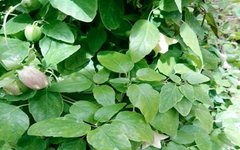Source: Zhangjiagang Traditional Chinese Medicine Hospital
In daily life,
we often come across many traditional Chinese medicinal herbs.
Can you recognize them all?
Jiangsu Provincial Administration of Traditional Chinese Medicine
has specially created
the “Encyclopedia of Chinese Medicine”
to help everyone understand the Chinese herbal medicines in daily life.
Please stay tuned.
▼▼▼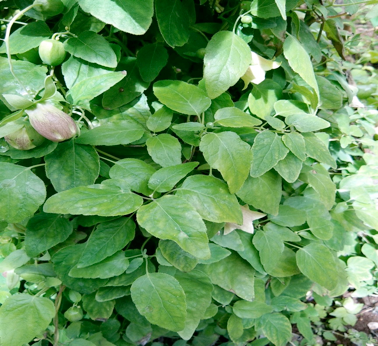
Source
This product is the dried root of the Campanulaceae plant Codonopsis pilosula (Franch.) Nannf., Codonopsis pilosula Nannf.var.modesta (Nannf.) L.T.Shen, or Codonopsis tangshen Oliv.
Alias
Lu Dang Shen, Shang Dang Shen, Fang Dang Shen, Lion’s Head Ginseng, Zhong Ling Cao, Huang Dang, Huang Shen, etc.
Production Area
Mainly produced in Shanxi, Gansu, Shaanxi, Sichuan, Qinghai, Ningxia, and Northeast China. Widely cultivated.
Discussion
Here we need to discuss and clarify several concepts to help better understand Dang Shen, a commonly used medicinal material!
1. The naming of Dang Shen first appeared in the Qing Dynasty in the books “Bencao Fengyuan” and “Bencao Congxin”, but its clinical use should be much earlier than the Qing Dynasty; it is mainly produced in the Shangdang County of Luliang, Shanxi, hence the name “Lu Dang Shen” became prominent. The Dang Shen from Wutai Mountain in Shanxi is also of good quality and is called “Tai Dang Shen”, with the source being the Campanulaceae plant Codonopsis pilosula.
2. The term “Shang Dang Ren Shen” in herbal texts originally referred to Ginseng (Araliaceae); at the same time, the ancient Shangdang region also produced a type of medicinal material from the Campanulaceae family, which was used medicinally very early. It was not until the Qing Dynasty that it gradually became recognized as a new medicinal material, named “Dang Shen”, although it was also referred to as “Shang Dang Ren Shen” in herbal texts.
3. Currently, Gansu is also a major production area for Dang Shen, divided into two categories: Bai Tiao Dang and Wen Dang. Bai Tiao Dang Shen is derived from the Lu Dang Shen introduced in the 1950s (with the source being Dang Shen), and is the mainstream product of Gansu Dang Shen today. The advantageous cultivation areas are Weiyuan County, Longxi County, Lintao County, Tongwei County, and Anding District of Dingxi City, which are commonly seen in the market. Wen Dang, on the other hand, is derived from the Codonopsis pilosula var. modesta, a unique historical variety in Gansu, with advantageous cultivation areas in Wenxian, Dangchang, and Zhouqu counties, mostly used for export and less common in the market. However, historically, it is generally believed that Wen Dang has better clinical efficacy than Bai Tiao Dang, and its price is also higher than that of Bai Tiao Dang.
▽ The following image shows the Dang Shen I harvested on-site at Wutai Mountain in Shanxi.
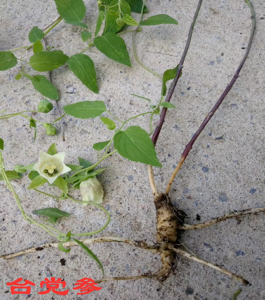
Identification of Characteristics
We can distinguish between Dang Shen, Codonopsis pilosula var. modesta, and Codonopsis tangshen based on their characteristics:
1. I have visited the Shouyang Medicinal Material Market in Dingxi City, Gansu, where farmers described that Wen Dang Shen has numerous horizontal stripes all over the material, with many black spots visible on the surface, and its texture is looser compared to Bai Tiao Dang, allowing for differentiation between the two. In the Shouyang market, farmers mentioned that Wen Dang Shen is also priced higher than Bai Tiao Dang of the same specifications, and its yield is much smaller.
2. The root tip of Dang Shen does not have a prominent “Lion’s Head” appearance. The surface is light gray-brown with deep and irregular longitudinal wrinkles, and there are sparse horizontal stripes near the root tip. The woody part occupies about half of the root radius; it is relatively light, easy to break, has a faint odor, no fragrance, and a sweet taste. Wen Dang has a larger diameter than Dang Shen, reaching up to 2.5 cm, with obvious wart-like protrusions and buds at the root tip, commonly referred to as “Lion’s Head”. The surface of Wen Dang is yellow-white to gray-yellow, and the dense ring-like horizontal stripes near the root tip often reach more than half of the total length. It has a special fragrance and a slightly sweet taste. The skin part is white with cracks, and the woody part is light yellow. The phloem is well-developed, occupying about two-thirds of the radius, making it more porous.
3. Codonopsis tangshen can grow up to 45 cm, has obvious longitudinal grooves, and sparse horizontal stripes at the top. The larger ones can be seen with a “Lion’s Head” appearance, but the stem scars are fewer; the smaller ones have a root tip smaller than the main body, called “Mudfish Head”. The texture is soft and solid, with fewer cracks on the cross-section.
▽ The following image shows Gansu Wen Dang and its slices.
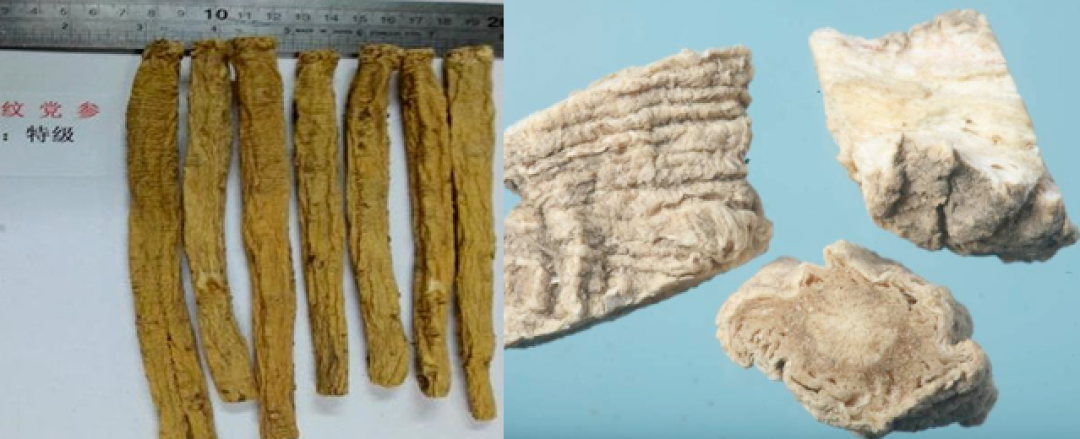
▽ The following image shows Dang Shen and its slices.
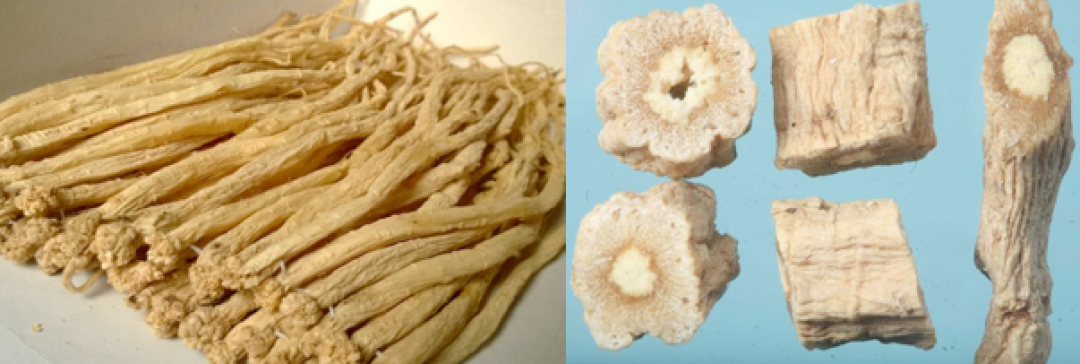
Properties and Channels
Sweet, neutral. Enters the Spleen and Lung meridians.
Functions and Effects
Strengthens the Spleen and Lung, benefits Qi, nourishes blood, generates fluids, supports the righteous Qi and expels pathogenic factors.
This product has a sweet taste and neutral nature, specifically entering the Spleen and Lung meridians, capable of tonifying the Spleen and Lung, benefiting Qi, and generating fluids. For generating fluids and nourishing blood, it is best used raw; for tonifying the Spleen and Lung, it is best used roasted. “Bencao Zhengyi”: “Dang Shen is capable of tonifying the Spleen and nourishing the Stomach, moistening the Lung and generating fluids, and strengthening the middle Qi, which is not much different from Ginseng. Its most valuable aspect is that it strengthens the Spleen without being drying, nourishes the Stomach Yin without being damp, moistens the Lung without being cold, nourishes the blood without being overly rich, invigorates the clear Yang, and stimulates the middle Qi without the drawbacks of being overly dry.” “Bencao Fengyuan”: “Shang Dang Ren Shen, although it does not have the strong warming and tonifying effects, has the ability to sweetly and neutrally clear the Lung, and is not like Sha Shen, which is cold and specializes in draining Lung Qi.”
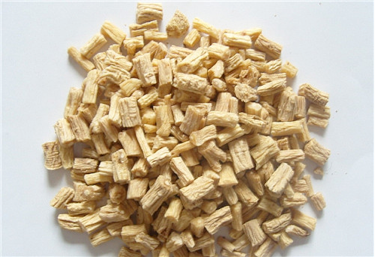
Processing Standards
Raw Dang Shen:
Original medicinal material, remove impurities, cut, and dry to obtain.
Rice-fried Dang Shen:
Place rice in a hot pan, heat over medium heat until smoking, then add Dang Shen and stir-fry until the rice turns a yellowish color and the Dang Shen is coated with a roasted color, then remove, sieve out the rice, and cool. Use 20 kg of rice for every 100 kg of Dang Shen.
Honey-roasted Dang Shen:
Dilute an appropriate amount of honey with warm water, mix with Dang Shen, let it sit until the honey water is absorbed, then stir-fry in a hot pan until the Dang Shen is golden and not sticky, then remove and cool. Use 10 kg of honey for every 100 kg of Dang Shen.
Additionally, Dang Shen processing in its production area often uses sulfur fumigation, so like other varieties such as yam, attention should be paid to sulfur residue issues. The Dang Shen slices from regular manufacturers and medical units meet national testing requirements and can be used with confidence.
Dosage and Administration
Internal use: decoction, 9–30 grams, or prepared as a paste, in pills, or powder.
Contraindications
Not to be used in cases of excess conditions, heat conditions; not to be used in cases of Qi stagnation or excessive anger; in cases of deficiency of the righteous Qi with excess pathogenic factors, it should not be used alone.
END

Scan the QR code to follow “Jiangsu Traditional Chinese Medicine” immediately.

